University Finance: Introduction to Insurance Assignment Analysis
VerifiedAdded on 2020/04/01
|6
|707
|163
Homework Assignment
AI Summary
This assignment provides a comprehensive overview of insurance principles, addressing key concepts such as insurable risk, the benefits of insurance to society and individuals, and the identification of physical hazards. The solution analyzes different types of risks, including their measurability and definability, and explores real-world examples. It also delves into the advantages of insurance, covering financial security, savings habits, and investment opportunities. Furthermore, the assignment examines the concept of reciprocal insurance exchanges and their benefits to businesses, emphasizing the flexibility and member-driven control they offer. The assignment uses references to support the analysis.
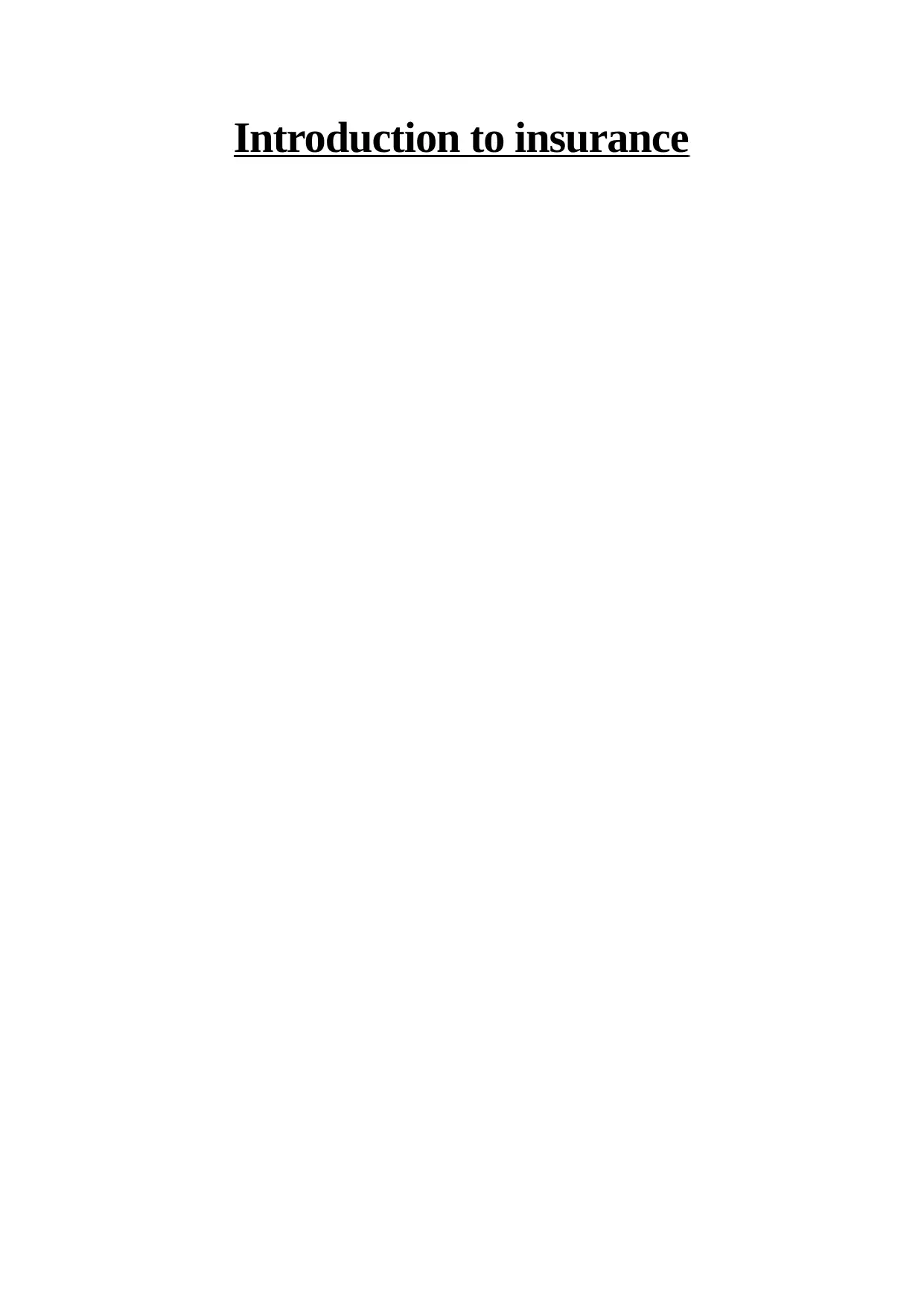
Introduction to insurance
Paraphrase This Document
Need a fresh take? Get an instant paraphrase of this document with our AI Paraphraser
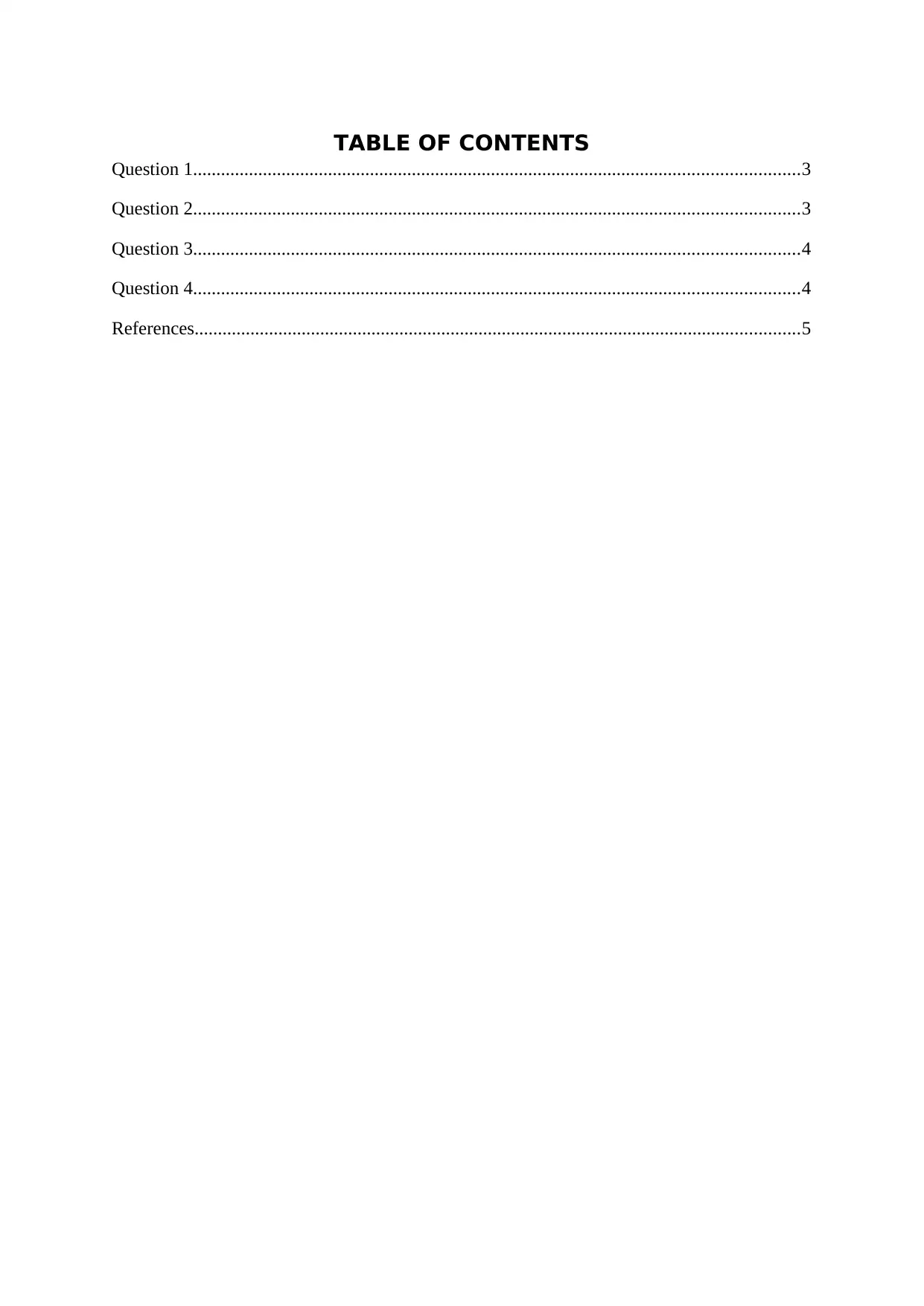
TABLE OF CONTENTS
Question 1..................................................................................................................................3
Question 2..................................................................................................................................3
Question 3..................................................................................................................................4
Question 4..................................................................................................................................4
References..................................................................................................................................5
Question 1..................................................................................................................................3
Question 2..................................................................................................................................3
Question 3..................................................................................................................................4
Question 4..................................................................................................................................4
References..................................................................................................................................5
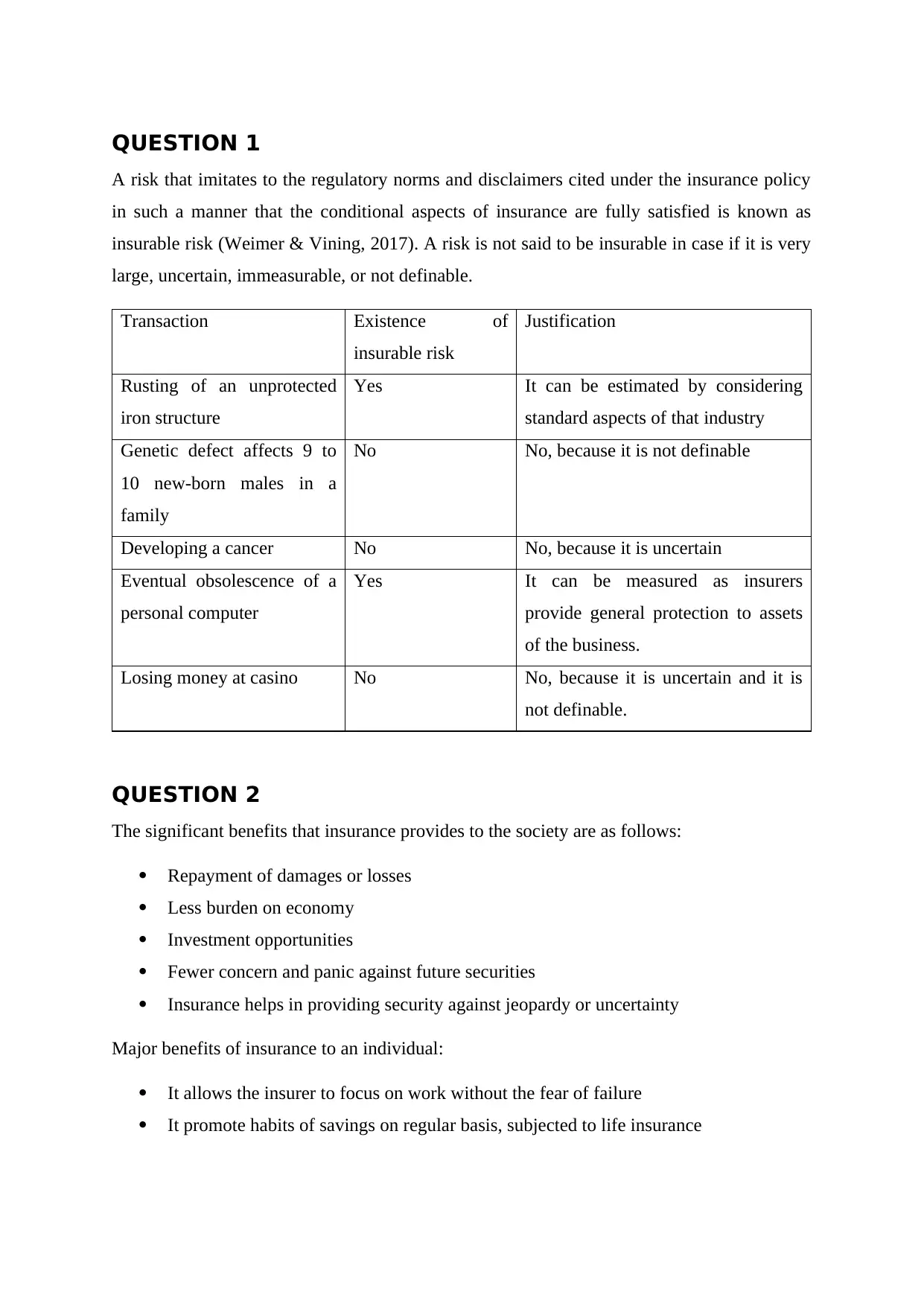
QUESTION 1
A risk that imitates to the regulatory norms and disclaimers cited under the insurance policy
in such a manner that the conditional aspects of insurance are fully satisfied is known as
insurable risk (Weimer & Vining, 2017). A risk is not said to be insurable in case if it is very
large, uncertain, immeasurable, or not definable.
Transaction Existence of
insurable risk
Justification
Rusting of an unprotected
iron structure
Yes It can be estimated by considering
standard aspects of that industry
Genetic defect affects 9 to
10 new-born males in a
family
No No, because it is not definable
Developing a cancer No No, because it is uncertain
Eventual obsolescence of a
personal computer
Yes It can be measured as insurers
provide general protection to assets
of the business.
Losing money at casino No No, because it is uncertain and it is
not definable.
QUESTION 2
The significant benefits that insurance provides to the society are as follows:
Repayment of damages or losses
Less burden on economy
Investment opportunities
Fewer concern and panic against future securities
Insurance helps in providing security against jeopardy or uncertainty
Major benefits of insurance to an individual:
It allows the insurer to focus on work without the fear of failure
It promote habits of savings on regular basis, subjected to life insurance
A risk that imitates to the regulatory norms and disclaimers cited under the insurance policy
in such a manner that the conditional aspects of insurance are fully satisfied is known as
insurable risk (Weimer & Vining, 2017). A risk is not said to be insurable in case if it is very
large, uncertain, immeasurable, or not definable.
Transaction Existence of
insurable risk
Justification
Rusting of an unprotected
iron structure
Yes It can be estimated by considering
standard aspects of that industry
Genetic defect affects 9 to
10 new-born males in a
family
No No, because it is not definable
Developing a cancer No No, because it is uncertain
Eventual obsolescence of a
personal computer
Yes It can be measured as insurers
provide general protection to assets
of the business.
Losing money at casino No No, because it is uncertain and it is
not definable.
QUESTION 2
The significant benefits that insurance provides to the society are as follows:
Repayment of damages or losses
Less burden on economy
Investment opportunities
Fewer concern and panic against future securities
Insurance helps in providing security against jeopardy or uncertainty
Major benefits of insurance to an individual:
It allows the insurer to focus on work without the fear of failure
It promote habits of savings on regular basis, subjected to life insurance
⊘ This is a preview!⊘
Do you want full access?
Subscribe today to unlock all pages.

Trusted by 1+ million students worldwide
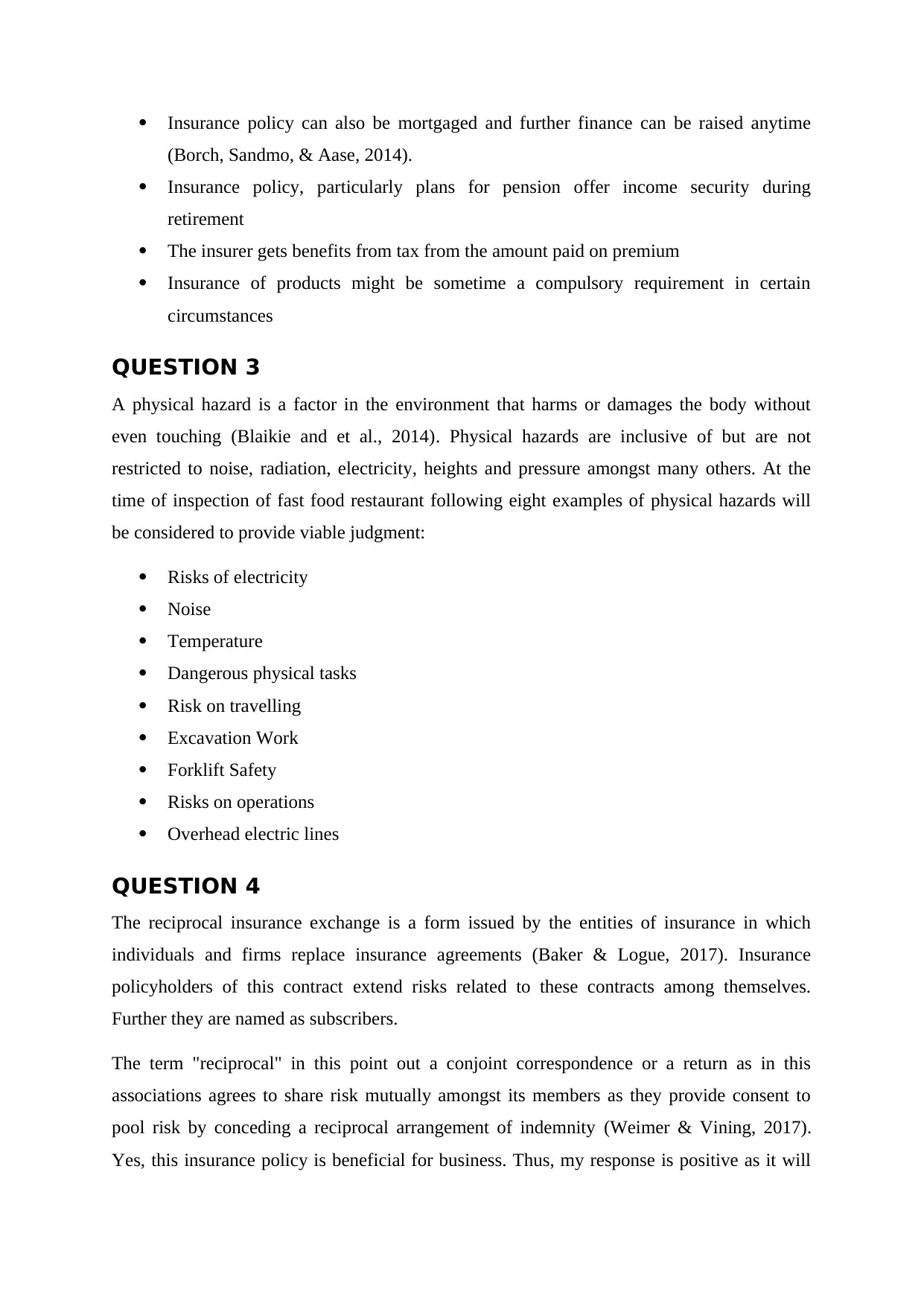
Insurance policy can also be mortgaged and further finance can be raised anytime
(Borch, Sandmo, & Aase, 2014).
Insurance policy, particularly plans for pension offer income security during
retirement
The insurer gets benefits from tax from the amount paid on premium
Insurance of products might be sometime a compulsory requirement in certain
circumstances
QUESTION 3
A physical hazard is a factor in the environment that harms or damages the body without
even touching (Blaikie and et al., 2014). Physical hazards are inclusive of but are not
restricted to noise, radiation, electricity, heights and pressure amongst many others. At the
time of inspection of fast food restaurant following eight examples of physical hazards will
be considered to provide viable judgment:
Risks of electricity
Noise
Temperature
Dangerous physical tasks
Risk on travelling
Excavation Work
Forklift Safety
Risks on operations
Overhead electric lines
QUESTION 4
The reciprocal insurance exchange is a form issued by the entities of insurance in which
individuals and firms replace insurance agreements (Baker & Logue, 2017). Insurance
policyholders of this contract extend risks related to these contracts among themselves.
Further they are named as subscribers.
The term "reciprocal" in this point out a conjoint correspondence or a return as in this
associations agrees to share risk mutually amongst its members as they provide consent to
pool risk by conceding a reciprocal arrangement of indemnity (Weimer & Vining, 2017).
Yes, this insurance policy is beneficial for business. Thus, my response is positive as it will
(Borch, Sandmo, & Aase, 2014).
Insurance policy, particularly plans for pension offer income security during
retirement
The insurer gets benefits from tax from the amount paid on premium
Insurance of products might be sometime a compulsory requirement in certain
circumstances
QUESTION 3
A physical hazard is a factor in the environment that harms or damages the body without
even touching (Blaikie and et al., 2014). Physical hazards are inclusive of but are not
restricted to noise, radiation, electricity, heights and pressure amongst many others. At the
time of inspection of fast food restaurant following eight examples of physical hazards will
be considered to provide viable judgment:
Risks of electricity
Noise
Temperature
Dangerous physical tasks
Risk on travelling
Excavation Work
Forklift Safety
Risks on operations
Overhead electric lines
QUESTION 4
The reciprocal insurance exchange is a form issued by the entities of insurance in which
individuals and firms replace insurance agreements (Baker & Logue, 2017). Insurance
policyholders of this contract extend risks related to these contracts among themselves.
Further they are named as subscribers.
The term "reciprocal" in this point out a conjoint correspondence or a return as in this
associations agrees to share risk mutually amongst its members as they provide consent to
pool risk by conceding a reciprocal arrangement of indemnity (Weimer & Vining, 2017).
Yes, this insurance policy is beneficial for business. Thus, my response is positive as it will
Paraphrase This Document
Need a fresh take? Get an instant paraphrase of this document with our AI Paraphraser
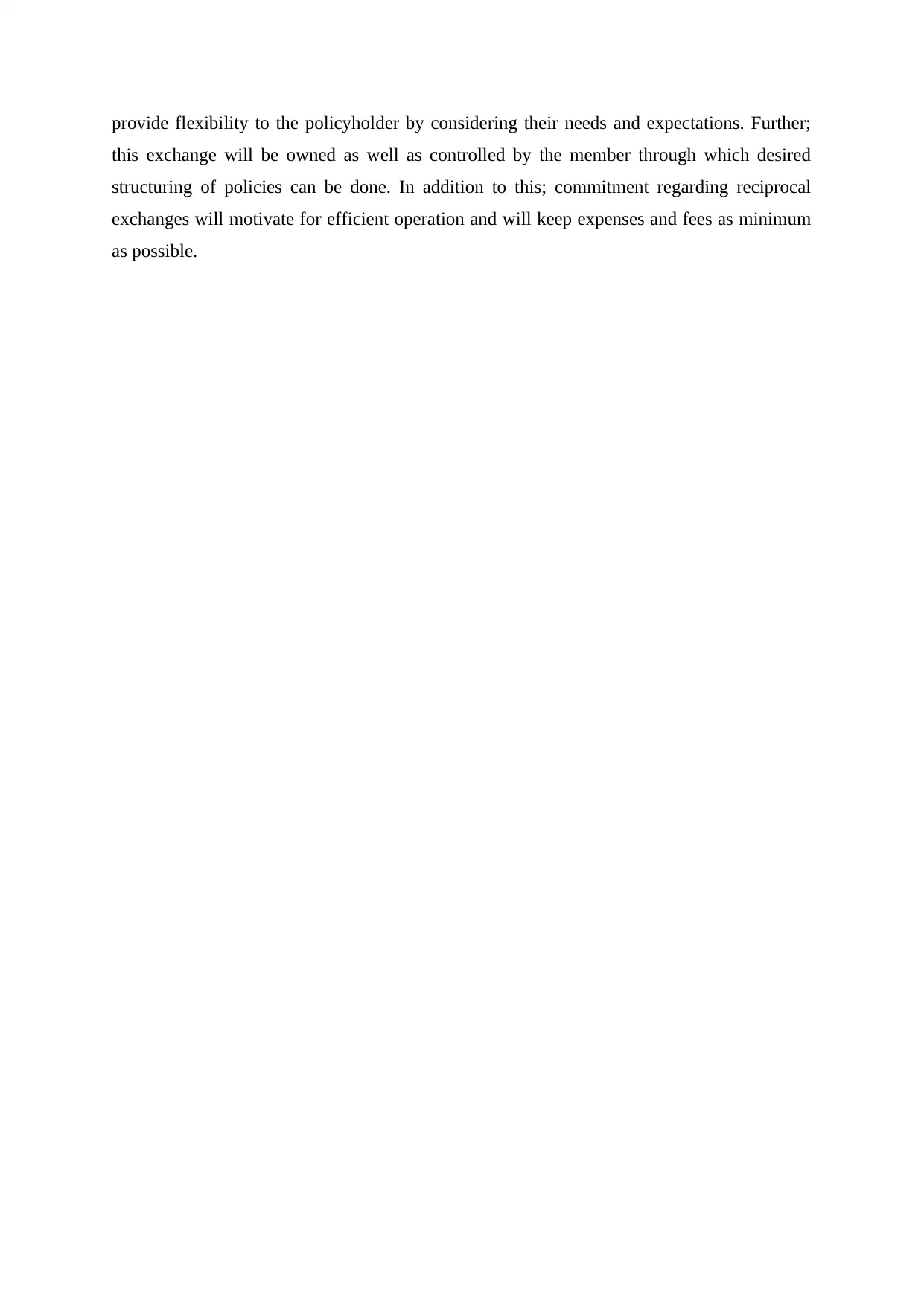
provide flexibility to the policyholder by considering their needs and expectations. Further;
this exchange will be owned as well as controlled by the member through which desired
structuring of policies can be done. In addition to this; commitment regarding reciprocal
exchanges will motivate for efficient operation and will keep expenses and fees as minimum
as possible.
this exchange will be owned as well as controlled by the member through which desired
structuring of policies can be done. In addition to this; commitment regarding reciprocal
exchanges will motivate for efficient operation and will keep expenses and fees as minimum
as possible.
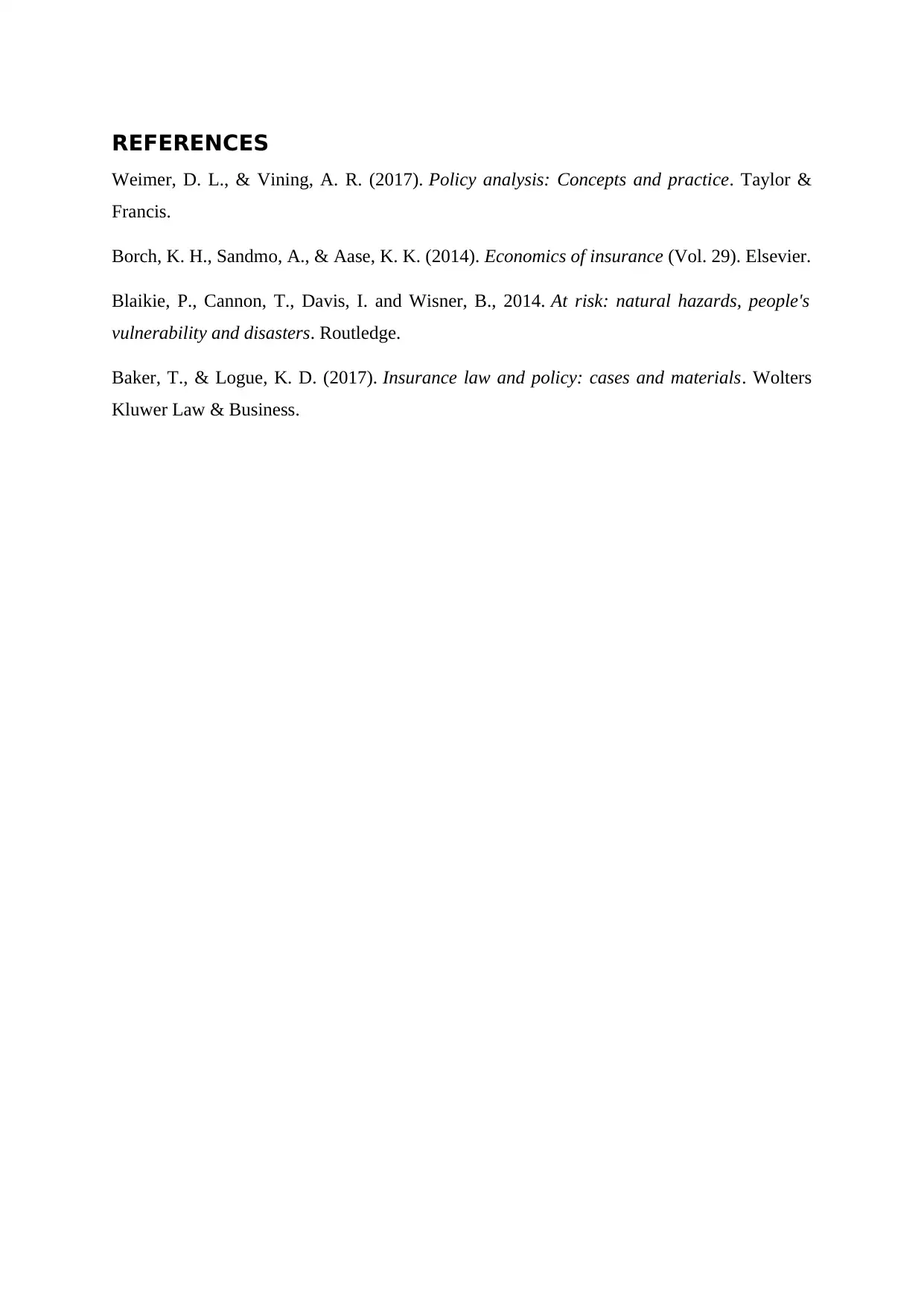
REFERENCES
Weimer, D. L., & Vining, A. R. (2017). Policy analysis: Concepts and practice. Taylor &
Francis.
Borch, K. H., Sandmo, A., & Aase, K. K. (2014). Economics of insurance (Vol. 29). Elsevier.
Blaikie, P., Cannon, T., Davis, I. and Wisner, B., 2014. At risk: natural hazards, people's
vulnerability and disasters. Routledge.
Baker, T., & Logue, K. D. (2017). Insurance law and policy: cases and materials. Wolters
Kluwer Law & Business.
Weimer, D. L., & Vining, A. R. (2017). Policy analysis: Concepts and practice. Taylor &
Francis.
Borch, K. H., Sandmo, A., & Aase, K. K. (2014). Economics of insurance (Vol. 29). Elsevier.
Blaikie, P., Cannon, T., Davis, I. and Wisner, B., 2014. At risk: natural hazards, people's
vulnerability and disasters. Routledge.
Baker, T., & Logue, K. D. (2017). Insurance law and policy: cases and materials. Wolters
Kluwer Law & Business.
⊘ This is a preview!⊘
Do you want full access?
Subscribe today to unlock all pages.

Trusted by 1+ million students worldwide
1 out of 6
Your All-in-One AI-Powered Toolkit for Academic Success.
+13062052269
info@desklib.com
Available 24*7 on WhatsApp / Email
![[object Object]](/_next/static/media/star-bottom.7253800d.svg)
Unlock your academic potential
Copyright © 2020–2025 A2Z Services. All Rights Reserved. Developed and managed by ZUCOL.
